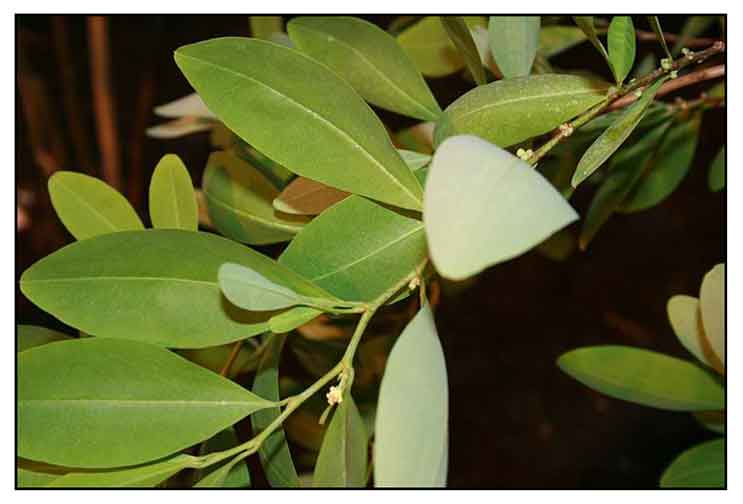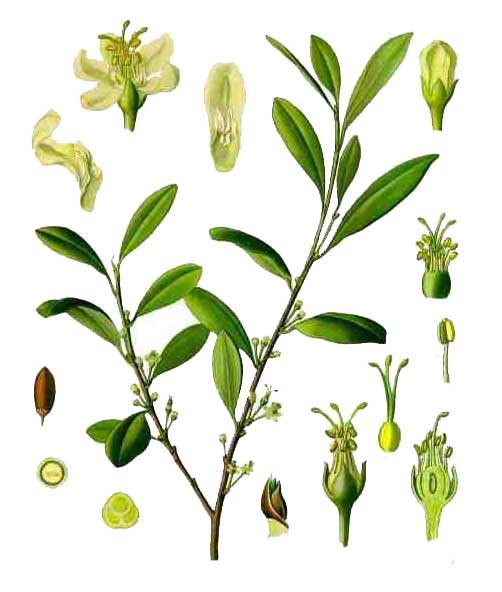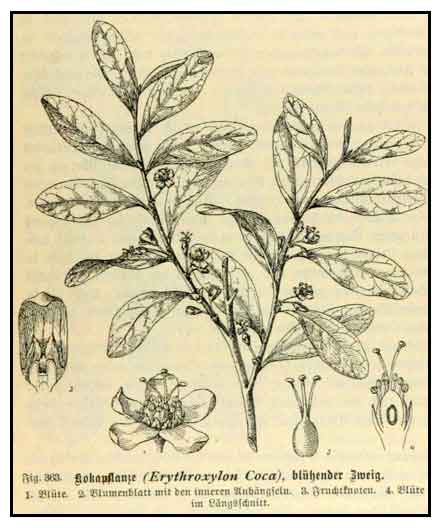 Botany Botany
Coca is an erect, branched, smooth shrub, growing from 1 to 2 meters in height. Leaves are thin, elliptic-oblong or narrowly obovate-elliptic, 2 to 7 centimeters long, with a blunt apex and pointed base. Flowers are white, several, on the axils of leaves. Fruit is oblong, 7 to 10 millimeters long, red when ripe, with a thin pulp. Plant flowers and fruits most of the year.
Distribution
- Recently introduced.
- Limited cultivation in Los Baños.
- Native of South America.
- Large scale cultivation in South America; also in Java and Ceylon.
 Constituents Constituents
- The pharmacologically active ingredient is the alkaloid cocaine, 0.3 to 1.5 percent in fresh leaves, averaging 0.8 per cent. associated with other alkaloidal substances, methylecgonin cinnamate, a-truxilline, B-truxilline, benzoyl-ecgonine, tropacocaine, hygrine, cuscohygrine, etc. These substances are collectively termed "cocaine" and are all derivatives of ecgonine.
- Cocaine prepared from the leaves of Erythroxylon coca, available as cocaine hydrochloride, a water soluble granule, taken orally, intravenously, or intranasally; or smoked as "freebase" or "crack" cocaine.
(9)
- Leaves yield per 100gDW: protein, 20.28 g, with lysine as limiting amino acid; vitamin E, 16.72 mg; trace vitamin D; calcium, 990.18 to 1033.17 mg; iron, 29.16 mg; zinc, 2.63 to2.71, magnesium, 196.69 to 225.19. Cocaine was the principle alkaloid 0.56g.
(8)
Properties
-Leaves considered stimulant, carminative, sialagogue, expectorant, aphrodisiac and emmenagogue.
- Produces mydriasis locally.
- Salts are nerve stimulant and restorative.
- A great digestive tonic.
- Absorption from the leaf is less rapid and efficient that from the purified forms, without the usual euphoric and psychoactive effects from the other abuse-forms of use.
- Although claims are made that cocaine is not an active ingredient fresh leaves, chewed or in decoction, small but measurable amounts in the blood after consumption of coca leaves tea.
Parts used
Leaves.
Uses
Edibility
- Leaves chewed or consumed as coca tea.
Folkloric
- In South America, leaves are chewed as tonic, for its great sustaining power.
- In Bolivia, it is one of the most common plants of folkloric medicine used as general stimulant.
- Leaves, when chewed, strengthen and preserve the teeth.
- Chewed after a heavy meal as digestive.
- For infants suffering from colic, warm milk in which leaves are stirred is given.
- In throat affections such as colds, catarrh and asthma, the leaves are chewed or smoked as cigarettes, or used in a hot decoction.
- Cocaine injected hypodermically and painted externally to produce local anesthetic.
- At one time, frequent used in minor operations, especially ophthalmic surgery, its anesthetic effect commencing in about 3 minutes and lasting for about half an hour.
- Reported folkloric use for bowel laxity, malaria, ulcers and bowel laxity; also, as aphrodisiac.
Medicinal
- Cocaine has been used to treat psychiatric symptoms such as sleep disturbances in depressive patients.
-
Used as anti-fatigue agent, antidepressant.
- Coca tea has been used decrease withdrawal and control relapse in cocaine dependence.
Others
- Coca is a vital part of the religious cultures of the Andean peoples of South America, and reading coca leaves a part of some divination practices.
- In some places, coca leaves still chewed traditionally, with small amounts of ilucta (from the ashes of quinoa plant), to soften its astringency and activate the alkaloids.
- Andean products: coca teas, granola bars, cookies, candies; coca leaves in an herbal liquer; and as natural flavoring agent in Red Bull Cola.
- Coca Colla, a Bolivian energy drink using coca extract as its base, was launched on the Bolivian market in April 2010.
 Studies Studies
• Anesthetic: (1) Cocaine is the only naturally occurring local anesthetic in medical use today. Nieman isolated and purified cocaine in 1859. Its use continued to become increasingly popular in the medical community, and in the 1880s, Koller introduced its use in the practice of ophthalmology and Hall, in dentistry. Increasingly, it became an ingredient of day-to-day products; Coca-Cola contained approximately 4.5 mg/180 cc. In 1914, when the problems with abuse and addiction became known, the Harrison Narcotics Act of 1914 was passed, banning the non-prescription use of cocaine in the U.S. It seeped slowly into the subcultural tributaries of abuse, reinventing itself as crack cocaine, irrevocably cementing itself as one of the mainstay preferences of the drug culture. (2) Its medicinal use today it confined primarily to operative procedures of the nose and throat and dermal lacerations in children. (3) Mechanism of action: Cocaine produces anesthesia by inhibiting excitation of nerve endings or by blocking conduction in peripheral nerves. It also has a profound CNS effect, blocking reuptake of dopamine in the midbrain leading to increased stimulation, euphoria and arousal. As cocaine level subsides, the dopamine level also decreases, with consequent depression and drug craving. (4) Cocaine also prevents norepinephrine reuptake in the sympathetic portion of the autonomic nervous system and may stimulate adrenal release of catecholamines. (5) It is the only anesthetic with vasoconstrictive properties resulting from blockade of norepinephrine reuptake. (6) Levels peak in 15-60 minutes after mucous membrane absorption. (7) Oxidative metabolism in the liver produces norcocaine, a substance with toxicity capable of producing severe hepatic damage. (8) Cocaine is detectable in the nasal mucosa 3 hours after application. Serum and urine levels are measurably detectable for about 6 hours following application. (8) Cocaine is available as flakes and crystals for application via cotton swabs, as tablets for use in preparation of topical solution. (9) Safe maximum dose is reported to be 200 mg or 2-3 mg/kg. (1) (2)
• Coca Tea and Positive Cocaine Urine Assay: Coca tea ingestion resulted in positive urine assay for cocaine metabolite. A history of coca tea ingestion should be considered when interpreting urine toxicology results. (3)
• Coca Leaf Chewing for Cocaine Maintenance: Study recommended the chewing of coca leaf, between 100 to 200 grams of coca leaf per week for the treatment of cocaine dependence. used for treating cocaine dependence. Social adaptation increased from 28% pretreatment to 48.8% post-treatment. (6)
• Effect on VO2max (Maximal Oxygen Consumption) / Exercise: VO2max is the measure of cardiorespiratory endurance, related to the ability to perform high intensity exercise for prolonged periods. Study evaluated the efficacy of homeopathic simplex Erythroxylum coca 200 CH in improving oxygen consumption during submaximal cycling. Results showed E. coca 200 CH to reduce exercise HR and exercise RPE during submaximal cycling, which may increase of the quality of life of patients with cardiovascular disease. (5)
• Coca Tea for Cocaine Dependence: Study supported the effectiveness of coca tea (CCT) for preventing relapse in cocaine-addicted patients. (7)
• Nutritional Potential of Coca Leaves: Study evaluated the nutritional potential of eight samples of coca leaves grown in Peru. See "Constituents" above. Two spoonfuls of coca leaf flour would provide less than 10% of dietary intakes of school children and adults for critical commonly deficient nutrients in the diet. Coca leaves cannot be recommended for food as they do not provide nutritional benefits and the absorbable cocaine and other alkaloids are potentially harmful. (8)
• Cocaine Use and Cardiovascular Complications: Acute myocardial infarction is the most commonly reported cardiac consequence of cocaine misuse, usually in young men, fit, healthy, or with minimal risk factors for cardiovascular disease. The mechanism for AMI induction is not largely understood. Cocaine effect should be considered in any young patient with minimal risk factors presenting with AMI, dilated cardiomyopathy, myocarditis, or cardiac arrhythmia. (9)
• Toxicity / Lethal Dose: Toxicity is lower when ingested orally by chewing coca leaves (Grabowski, 1984). The lethal dose of the alkaloid is 1,200 mg for adults (Noji & Kelen, 1989), but it has been reported that chronic users consume 5 to 10 g/day. The leaves of the South American plants contain 0.5% to 1% of the alkaloid cocaine. Coca leave chewers may use 20 to 80 g of leaves per day. This corresponds to an ingestion of 0.16 to 0.64 mg/day of the alkaloid. The lethal dose is not achieved by chewing the leaves. (10)
Toxicity
- Cocaine toxicity presents with profound adrenergic effects on the CNS, cardiovascular and respiratory systems: hypertension, tachycardia, potentially fatal arrhythmias, angina, myocardial infarction, CVA, TIAs, pulmonary edema, seizures, CNS depression.
- Crosses the placental barrier and readily passes into breast milk. It may cause various pregnancy complications: abruptio placenta, stillbirth, premature labor. Children born of cocaine mothers may suffer developmental delays.
Availability
Wild-crafted.
Seeds in the cybermarket.
|

![]()



 Botany
Botany Constituents
Constituents Studies
Studies 